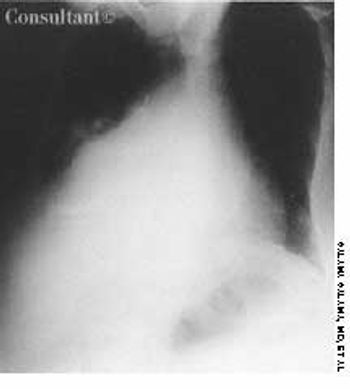
An 82-year-old woman was admitted to the hospital with severe dilated cardiomyopathy. The condition was alcohol-induced and had been diagnosed about 12 years earlier. The patient was taking angiotensin-converting enzyme inhibitors and diuretics.


An 82-year-old woman was admitted to the hospital with severe dilated cardiomyopathy. The condition was alcohol-induced and had been diagnosed about 12 years earlier. The patient was taking angiotensin-converting enzyme inhibitors and diuretics.

With a 1-year history of episodic wheezing, a 62-year-old woman (a smoker for the past 30 years) was being treated for bronchial asthma, but bronchodilator therapy did not control her symptoms. She was hospitalized with worsening dyspnea and a 4.5-kg (10-lb) weight loss over the past 3 months. There was no hemoptysis.
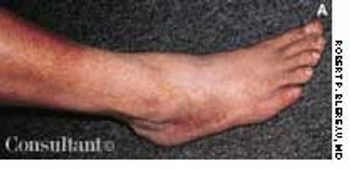
These orange-to-brown macules with red puncta, or cayenne pepper spots, are typical of Schamberg's disease (progressive pigmented purpuric dermatosis). The cause of this disorder is unknown, but it may be related to a cellular immune reaction or drug reaction.
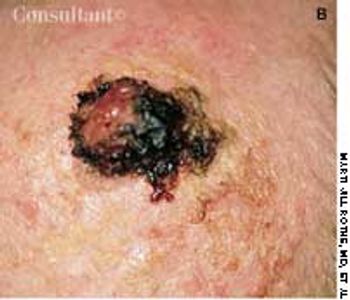
An 82-year-old man with Alzheimer's disease and atrial fibrillation was referred for evaluation of a lesion present for an undetermined period. It was initially noted 1 week earlier, at his first office visit with a geriatrician.

Cirrhosis and ascites developed in a 52-year-old man with a history of chronic hepatitis C and ethanol abuse. He was hospitalized because of bleeding esophageal varices, which were successfully treated with elastic band ligation.
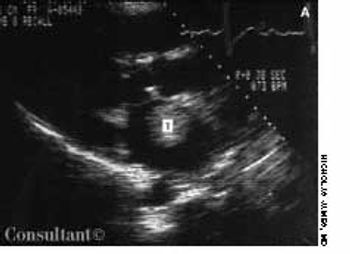
A 72-year-old man with a history of rheumatic heart disease presented with pulmonary congestion and syncope. Results of the cardiac examination suggested mitral stenosis and atrial fibrillation with a controlled ventricular response. Two-dimensional echocardi-ography revealed a large, free-floating ball thrombus (T) in the dilated left atrium and demonstrated rheumatic and severely stenotic mitral valve leaflets.
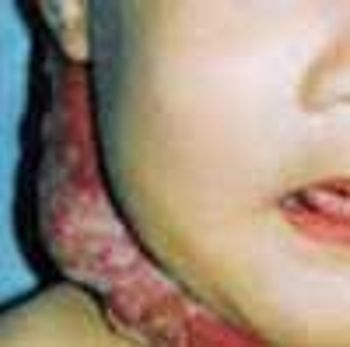
These collections of dilated vessels deep in the dermis and subcutaneous tissue are present at birth. They usually present as bluish or reddish lesions that are cystic, firm, and compressible. About 60% to 80% of cavernous hemangiomas undergo spontaneous involution, often with central clearing and fibrosis.

During a routine physical examination of a healthy 7-year-old African-American boy, this striking-and puzzling-hyperpigmentation was noted on his palms.

A 73-year-old man who had a history of long-standing essential hypertension, congestive heart failure, mild renal insufficiency, atrial fibrillation, and a mitral valve replacement presented with refractory hypertension. His medications included labetalol, irbesartan, and furosemide.

An 8-year-old boy was brought to his pediatrician for well-child care. On physical examination, an irregularly irregular heart rate was detected.
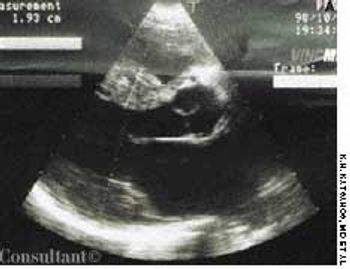
Dyspnea, orthopnea, and weight loss sent a 40-year-old woman for medical consultation. Fifteen years earlier, the patient had been nephrectomized because of left kidney lithiasis. There was no history of other symptoms or diseases.
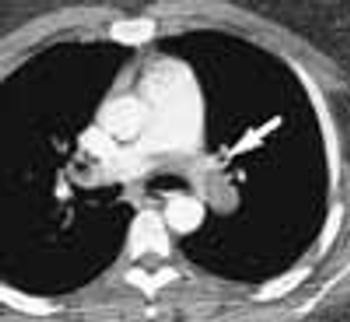
For 2 months, a 31-year-old woman had had dyspnea and dull, continuous retrosternal pain. She was admitted to the hospital, and a helical CT scan of the thorax identified a saddle pulmonary embolism. An ultrasonogram revealed deep venous thrombosis (DVT) in the left leg. Intravenous heparin was given; the patient was discharged, and warfarin was prescribed.
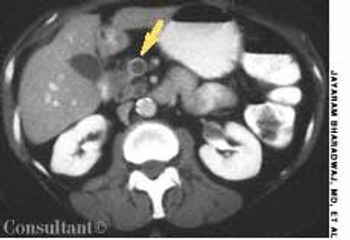
A 65-year-old woman with metastatic adenocarcinoma of the colon was undergoing chemotherapy following a colectomy and a hepatic wedge resection. The physical examination and laboratory data were unremarkable.
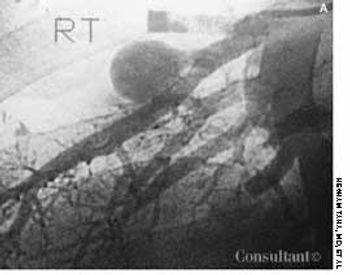
A 22-year-old man complained of progressive shortness of breath and abdominal distention. Three years before, he had completed chemotherapy for Hodgkin's disease and had since been in remission. Recently, he had been treated for tonsillitis with oral antibiotics.

A 76-year-old woman had a 40-year history of rheumatoid arthritis (RA). She had repeatedly refused treatment with disease-modifying drugs, including methotrexate. Nodules began to develop 15 years after the initial diagnosis; they recurred after surgical removal.
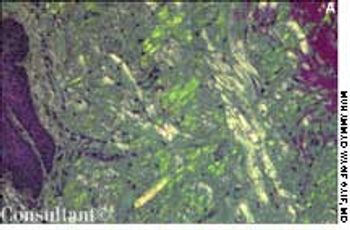
A 63-year-old African American man presented with orthopnea and pedal edema that had worsened during the past 4 months. Macroglossia was noted.

Tai Chi (also known as T'ai Chi Chuan, Taijiquan) is a form of mind-body exercise that has its roots in ancient Chinese martial arts. Throughout Asia, it is often practiced for preventive health, especially among the elderly. In recent years, Tai Chi has become popular in the West among all age groups and has been studied as a therapy for various medical conditions.

A 67-year-old woman was referred for evaluation of exertional dyspnea, with multiple episodes of fever, cough, and pneumonia. She had a long history of cough with sputum and had been admitted several times for exacerbations of chronic obstructive pulmonary disease and pneumonia. She received maintenance therapy with an ipratropium and albuterol combination, fluticasone, and salmeterol, but she continued to experience exertional dyspnea, with an average of 5 or 6 exacerbations and 2 hospital admissions a year.

56-year-old woman presents for evaluation of several syncopal episodes that occurred during the past 2 weeks. These episodes were associated with various activities--eating while seated, walking slowly, and standing upright--and rendered her briefly unconscious.

A 55-year-old man complains of fatigue. Although he sleeps 8 hours every night, he has to push himself to perform his usual daily activities. He has also experienced loss of libido and episodic impotence, which he ascribes to the fatigue.

A 51-year-old man with a 20-year history of asthma and seasonal allergies presented with low-grade fever, progressive dyspnea on exertion, and wheezing that had persisted for 2 weeks. Four days earlier, he had been seen by his primary care physician and had started levofloxacin therapy. However, his respiratory symptoms had worsened, warranting hospitalization. He also reported pain in the abdomen and left flank and pain and swelling in the right metacarpophalangeal and right shoulder joints.

Abstract: The standard therapies for acute exacerbations of chronic obstructive pulmonary disease include short-acting bronchodilators, supplemental oxygen, and systemic corticosteroids. For most patients, an oxygen saturation goal of 90% or greater is appropriate. Bilevel positive airway pressure (BiPAP) is usually beneficial in patients with progressive respiratory acidosis, impending respiratory failure, or markedly increased work of breathing. However, BiPAP should not be used in patients with respiratory failure associated with severe pneumonia, acute respiratory distress syndrome, or sepsis. Systemic corticosteroids are appropriate for moderate to severe acute exacerbations; many experts recommend relatively low doses of prednisone (30 to 40 mg) for 7 to 14 days. Antibiotic therapy is controversial, but evidence supports the use of antibiotics in patients who have at least 2 of the following symptoms: increased dyspnea, increased sputum production, and sputum purulence. (J Respir Dis. 2005;26(8):335-341)
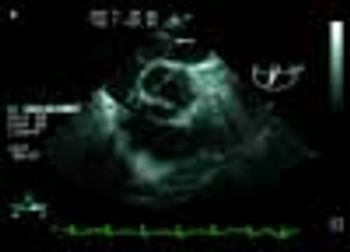
A 62-year-old woman with a 25-year history of dyspnea was hospitalized because of hypoxemia. The dyspnea had become more severe during the past few years; it was worse in the standing position, was not exacerbated by walking, and was immediately relieved on lying down. She had no seasonal variation or environmental trigger of the dyspnea.

32-year-old man presents with a 4-day history of fever (temperature as high as 38.8 C to 39.4 C with severe rigors, chills, and profuse night sweats; generalized myalgias, including dull, aching headache; and dry cough.

Abstract: Although smoking cessation is still the most impor- tant intervention in chronic obstructive pulmonary disease (COPD), a variety of pharmacologic therapies are available to help manage symptoms. Short-acting ß2-agonists and/or ipratropium should be taken as needed, and the use of additional therapies is based on the severity of disease. Patients with moderate or severe COPD should regularly take 1 or more long-acting bronchodilators. The long-acting ß2-agonists salmeterol and formoterol have been demonstrated to improve health-related quality of life. Newer therapies include the long-acting anticholinergic tiotropium and a salmeterol-fluticasone combination. These agents improve forced expiratory volume in 1 second and may reduce the rate of acute exacerbations. For patients with moderate to very severe COPD, participation in a pulmonary rehabilitation program can improve health status, quality of life, and exercise tolerance. (J Respir Dis. 2005;26(7):284-289)